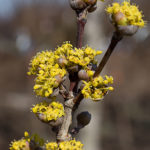Life after Serviceberries

I still remember planting my first serviceberry with my dad a long time ago – actually, a very long time ago. What struck me most were the many names for the same plant – Amelanchier canandensis, Shadblow, Juneberry, Serviceberry. Somewhat unusual at that time, little did I realize what a high-demand plant it would become. Therein lies the problem. It seems no matter how many are brought in every year we quickly run out. Landscape contractors, designers, and architects ignore so many other great similar-usage plants. Even when repeatedly told we are out till fall dig season, the requests keep coming. There are many good substitutes. In fact, there are many plants that would be better first choices!

'Arnold Promise' Witchhazel

'Arnold Promise' Witchhazel
Even more shade tolerant than Amelanchier are witchhazels. Larger, fall-blooming, native Hamamelis virginiana could match serviceberry with respect to growth rate and size. H. vernalis and the many crosses of H. mollis and chinensis (i.e.’ Diana, Jelena, Arnold Promise,’ et al.) are slower-growing but offer patio shade and a much greater color range. Native multi-stemmed dogwoods (Cornus florida and fl. ‘Rubra’) give a layered look; same usage but different than the arched or cascading habit of A. canadensis.

Cornus florida 'Princess Emily'
Also, a terribly-ignored, rugged, and problem-free group of plants are the Wrinkled Viburnums. In particular, Viburnum rhytidophyllum, Leatherleaf, and V. x rhytidophylloides ‘Willowwood’ are monsters. Achieving height and spread toward fifteen feet, they have an arching habit and are semi-evergreen. These offer spring flower, fruit, fall color, (and winter foliage interest).

Viburnum rhytidophyllum - Leatherleaf Viburnum
A perfect match for Amelanchier ‘Rainbow Pillar’ is Cornus mas ‘Golden Glory.’ This Male Dogwood is very hardy and an early bloomer not usually susceptible to freeze damage. It has exfoliating bark and edible fruit. Its structure provides great winter interest.

Cornus mas 'Golden Glory'
Another easy sub for Amelanchier is Viburnum prunifolium, native Blackhaw, large, global, and a great bird attractor. A shrub easily surpassing fifteen feet in height and spread.

Viburnum prunifolium - Blackhaw Viburnum
So, yes, there is life after serviceberries. I can't promise you that these or any other plants are going to be in stock when you are looking for substitutions, so don't be afraid to consider other options. Let's enhance our landscapes in terms of variety and plant health!
